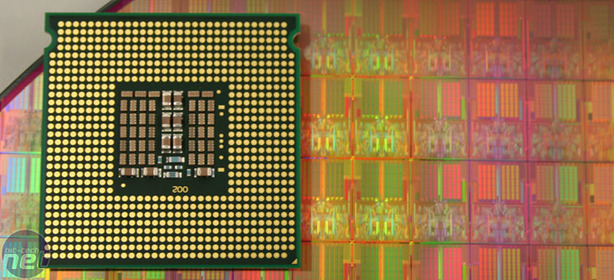
Overclocking
We were naturally quite cautious given a new process which lowers the internal voltage and makes it more susceptible to over-voltage when overclocking. We weren't prepared to sacrifice such a particularly expensive CPU so we upped the voltage to a rather tame 1.435V on our Asus Blitz Extreme, with a Zalman CNPS9700 CPU heatsink.It just kept going.
4GHz, 4.1, 4.25... 4.35. Literally 10 minutes work with a combination of front side bus and multiplier and we had the machine booting into Windows and Prime95ing at 4,350MHz. Our CPU is an engineering sample so we'll come back to overclocking when better price-performance retail versions come available, but with more voltage, better cooling and obviously more time to investigate the limits these things should fly.
Those who can get hold of them and are brave enough are going to have the closest thing to home super computers ever available - £500 should buy you a Vapochill or hardcore TEC/watercooling setup which isn't too far out of some people's reach. It'll naturally change the landscape of CPU performance e-peen on the net as 3DMark or SuperPi scores will get inevitably re-broken in the near future.
For the rest of us though, the more affordable desktop versions should arrive early next year which is a bit of a problem: Crysis and UT3 are out in the next few weeks, so what do you do? Wait until Christmas where some of the younger readers will have a bit more cash from the family and upgrade then (those of us who are older, it will be considerably less money though) or bite the bullet for a few months and get an Q6600 G0 or E6750 and clock the nuts off it. A cheap P35 board and one of these could make for a good interim solution until then because remember AMD has yet to show its hand as well.
Power Consumption
So the new 45nm process gives you a quad-core CPU for the power cost of a dual core 65nm Intel CPU. AMD's high-end Athlon 64 X2s still use the 90nm SOI manufacturing process and have reached the end of their limits, just like it was back with Pentium 4 Preshot. Thus, it's no surprise that they don't square up at all well here.
These results are without Intel EIST and C1E states enabled or even AMD PowerNow, but using that will typically drop the Idle wattage (and CPU clock) down further as well. Overall, 240W at the wall (negating GPU and other subsystem load) is really very little considering the performance you're getting and the dual-core Wolfdale processors should be even lower than the already low 65nm G0 chips currently on sale.

Final Thoughts
We think it's fair to say that Intel's Penryn architecture can be regarded as a success, as it offers some decent performance enhancements over existing processors, while using much less power in the process. Most of the success can be attributed to the "brute force" methods like the 50 percent larger cache instead of the more delicate features like SSE4, which requires specific optimisation in software to see the benefits. However the most interesting changes should be in the mobile parts which feature some great new technologies.Specifically, the Core 2 Extreme QX9650 is of course a processor that everyone would love to own, but very few will have the money or need for it. Most of us will want to wait for the mainstream dual- and quad-core 45nm CPUs to arrive, but the Extreme Edition has never been about volume. It's about a technological demonstration that creates a halo effect to help sell the more mainstream-orientated products. I guess you could think of the QX9650 as the Bugatti Veyron of the CPU world - it annihilates everything in its path.
For a simple "refresh" it's made more strides than we would have expected and this should certainly be enough to keep us happy until Nehalem arrives next year. Let's not forget the competition though; we hope and beg AMD's upcoming Phenom processor is competitive, so that competition will continue to be healthy. This is important for the market, as it drives choice, innovation and keeps prices down for us consumers.
- Performance
- x
- x
- x
- x
- x
- x
- x
- x
- x
- x
- 10/10
- Value
- x
- x
- x
- x
- x
- -
- -
- -
- -
- -
- 5/10
- Overall
- x
- x
- x
- x
- x
- x
- x
- x
- -
- -
- 8/10

MSI MPG Velox 100R Chassis Review
October 14 2021 | 15:04








Want to comment? Please log in.